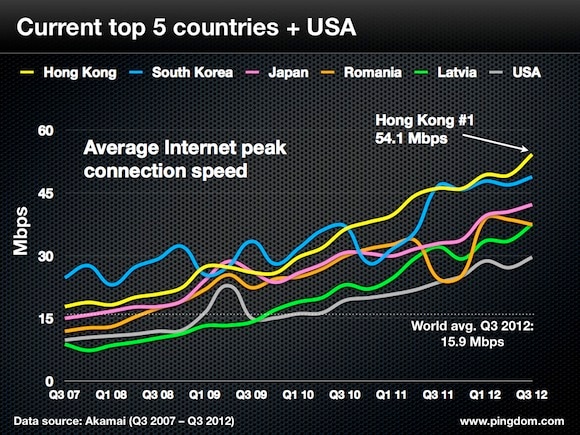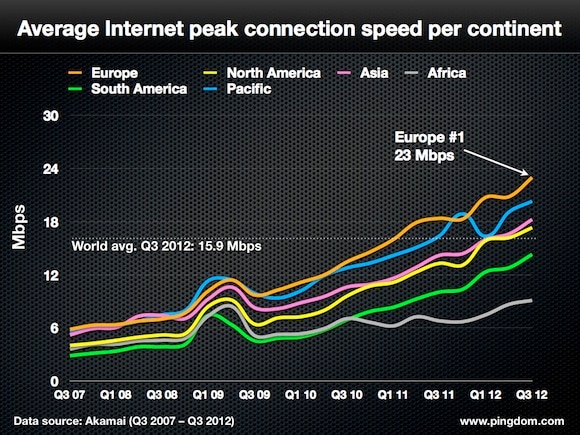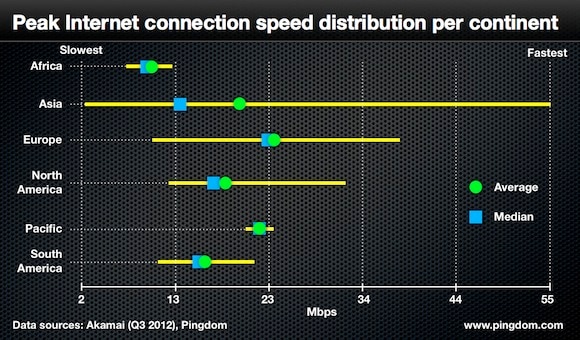
It should come as no surprise that the world’s fastest Internet connection speeds can be found in Asia, with Hong Kong offering an impressive 54.1 Mbps, the fastest in the world. But would you believe us if we said that the world’s slowest connection speeds can also be found in Asia? How is that possible, you ask? Read on for all the numbers.
A few Asian countries lead the way in Internet speed
Based on the latest data on Internet speeds around the world, we made a list of the top 5 countries. The top three countries out of the five on the list can be found in Asia.

A few things worth noting:
- In the latest quarter, Hong Kong (54.1 Mbps) has increased its lead over South Korea (48.8 Mbps).
- Of the current top five countries, it’s only Japan that has been able to pass Hong Kong and South Korea in the chart since 2007.
- Hong Kong and South Korea have been rather lonely at the top, widening the gap to the other countries since the third quarter 2011.
- The United States has dropped down to 14th place in the latest quarter, and added here just for reference.
- None of the big European countries, like France, Germany and United Kingdom, made the top five list. United Kingdom, currently in 16th place with an average peak connection speed of 28.1 Mbps, has the highest ranking of the three.
But Europe is the fastest continent
This made us wonder what would happen if we were to concentrate on the Internet speed of whole continents and not just the top countries. Would Asia then be the continent with the fastest Internet?
Maybe it’s just us, but we were taken by surprise by the results.

Asia is not even the second fastest continent, but the third.
Except a short period in 2011 and 2012, Europe has been the continent with the highest average peak connection speed since the beginning of 2009. In fact, Europe seems to have increased the average peak connection speed more than the other continents during the most recent quarter.
Asia has both the fastest and the slowest Internet speeds
Since three Asian countries have the fastest Internet in the world, but Asia as a continent only manages third place, we wanted to try to find an explanation to this.
We plotted the distribution of the average peak Internet connection speeds for each continent, including the average and median. This revealed some interesting things, especially for Asia, as you can see in the chart below.

You can download a larger version of this picture.
Here are a few interesting aspects to note:
- Asia clearly has the largest distribution of Internet speeds of any continent.
- Looking only at the median speed, Asia has the lowest number of all continents except Africa.
- The slowest average peak connection speed in Asia is that of Iran at 2.9 Mbps.
- Malaysia, with an average peak connection speed at 18.2 Mps, represents the average country in the continent very well.
- The country closest to the median would be Lebanon at 12.6 Mbps in average peak connection speed.
- Africa, Europe, South America, and the Pacific (which includes Australia and New Zealand) all have a rather even distribution; consequently they have a median and an average that are both located near the middle.
Asia – continent of extremes
What is clear from this is that not every person across Asia enjoys the same superfast Internet as Hong Kong and South Korea. In fact, many people have some of the slowest Internet speeds anywhere on the planet.
But what is also clear is that the potential for growth in Asia is astonishing. For example, China has 565 million Internet users, which represents only 42.1% of the population. Based on our findings, it would seem like Internet speeds in many parts of the continent would have to increase considerably, so that the typical person in Asia (the median) would enjoy a better Internet experience.
The question is, when will that happen?
About the data: The data we have based this study on comes from the quarterly State of the Internet report by Akamai. We have added some of our own calculations for averages and medians, and we have followed this model for dividing the world into continents. The increase in Internet speeds around Q1/Q2 2009 is an anomaly in the data, which we cannot account for.
Top picture: PKOM / Shutterstock.com
























